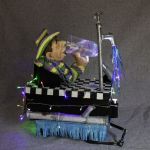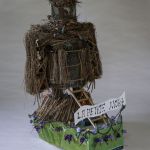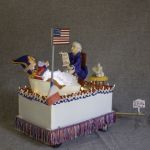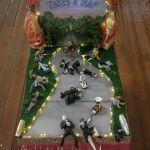
Kathleen Kraus, I Don’t Think So, from 2011’s “Too Little Too Late” Parade.
Share This
Print This
Email This
Mardi Gras in Miniature: The ‘titREX Parade
South Writ Large connected with New Orleans-based photographer and artist, Jonathan Traviesa, to inquire about the annual Mardi Gras miniature parade, ‘titREX. As one of its founding members, he shared his insights and impressions about the parade’s origins and tiny scale.

Street view from 2010’s “The Bare Minimum” Parade. From Right to Left: Trish Nugent, Queen Float (Pollyanna); Todd Schrenk, King “titREX“ Float.
What inspired the founders of ‘titREX, the original (and only) Mardi Gras microkrewe composed of tiny floats, to form it?
The genesis of the ’titREX parade comes from late-night BS sessions with a small group of friends during the initial months and years following the levee failures of 2005. Among tons of casual, wild ideas brought forth in that exciting/anxious time—a shoebox float parade was the one that actually got us off our talk—and into action.
Some of the anxiety we shared at that time was that New Orleans’ rituals—like Carnival parades—might fully cede to the ongoing trend of overwhelmingly large spectacle parades. Those experiences—while awesome in their own right—began to feel a little consolidated and worn. We decided to play with scale in reverse and make tiny floats; I should add that most of our founding members remember growing up in the region making shoebox floats in art class during carnival season. I think we all shared the notion that going small could still be both powerful and beautiful.
How do scale and humor interact?
I think in any form of miniature-making, there is an obsession with details that can spill over into absurdity. It’s been said that ’titREX’s social and political satire is top-notch in the city. If that is or was ever true, it may be because our biting content is served through the cuteness factor of these ridiculously small floats.
There is also a key difference between a ‘titREX shoebox float and most other, conventionally sized floats: the actual shoeboxes don’t have any “live” riders. The whole float then is like an open canvas that is more in line with a diorama tradition. And, of course, that tradition has yielded some strange, often funny fabrications.
Are there parameters for what is required to enter a float into the parade, i.e. size, material, content, etc.?
(There are more parameters or rules in ‘titREX than one would casually assume. For us, we like to strike a careful balance of freedom nestled within certain boundaries that help define the parade. In other words, we enjoy providing and participating in the wild energy of Mardi Gras, but we also rely on some rules to keep the coherence of the ’titREX magic.)
Several years back, after the first parade or two, many of the founding members noticed that the size of the floats was getting larger and larger. In an attempt to keep our parade “small,” we actually came up with the maximum dimensions for one’s float. I can’t remember exactly what those figures are, presently, but we went so far as to build a proscenium to those specs; any float that didn’t fit through was not allowed to roll. I don’t think it’s ever been enforced, however! Bottom line in ‘titREX is that you have to use a shoe box as the infrastructure for a float, and ultimately, the scale should reflect that.
What about the throws?
‘titREX throws are extra special because most if not all of them are handmade. And yes, they are very small. Each float team usually designs various small throws that thematically connect them back to their individual float.
How would you describe the people who participate? For example, are they young or old; families or single people; from a particular neighborhood, bar, or clique of friends?
Absolutely, the parade started among a handful of friends. In fact, our first year maybe we only had about ten floats more or less, and the sparse crowds were more friends. The next couple of years, as interest began to significantly grow, we fleshed out the number of floats to that of a conventional parade—which is to say around thirty floats. These newer participants primarily extended from our circle of friends. Years later, one of our challenges became how to keep the parade under control size-wise while still respecting people—at this point, more random folks from the general public—who really wanted to join in somehow. We have some measures now like a few guest memberships rotating every year, as well as a special guest artist float maker.
Is there anyone who doesn’t like the parade?
No. Everyone loves ‘titREX!
I’m sure there are haters out there—like there are for most things. Perhaps some folks who perceive the parade as an exclusive, insider-ish clique have some complex feelings. Again, we are sensitive to that and have tried to provide some opportunities for those who really, really want to join in.
What are the most prevalent themes for the parades? When floats are satirical, what or who are the most common targets of the satire?
Like many Mardi Gras parades, we have almost comically generic parade themes year in and year out. For ‘titREX, it’s often some clever phrase that always references ideas of smallness. Of course, we do have a strong satirical edge contained within each individual float, primarily. The targets of which are common within historic trends in Mardi Gras culture: current events, local politics, literary history, etc.
Are there any additional stories you wish to share to give our readers a sense of the spirit of this parade?
Sure, behind the scenes, once we determine an upcoming year’s theme, individual members begin to host “throw” parties starting in the fall and leading up to the parade date. Essentially, these are gatherings that promote socializing and overall camaraderie leading up to the new season. Lots of good creative work happens at these parties; ideas are shared and energy is built.
In the public realm, my favorite thing about ‘titREX is how interactive the crowd can get. First off, since we are a very small-scaled parade, the crowd is arms lengths away. (There is also a subtle undoing of the intentional social hierarchy imposed by much larger conventional floats with their riders towering over the masses.) Over the years, we’ve seen the crowd show up with small regalia too. Little dolls on little ladders with little signs etc. There is a mythical legend from way back when we had a different route in one of the first years. A spectator brought out a small train set designed to block our parade as we crossed the Bywater railroad tracks. It’s proof the absurdity is infectious!
Photographs of ‘titREX Floats by Jonathan Traviesa
- Jeannie Detweiler, Anne Hull, & Susan Dunlap, No Tall Drink of Water, from 2016’s “No Big Deal” Parade.
- Julie Ebel, Babes ’N Arms, from 2016’s “No Big Deal” Parade.
- Michelle Melancon, Godzilla vs. the Butterfly Effect, from 2016’s “No Big Deal” Parade.
- Jeremy Yuslum, Title Float, (or Wickerman), from 2010’s “Le Petit Mort” Parade.
- Jeannie Detweiler & Susan Dunlap, Bare Men ’N Nem, from 2013’s “The Bare Minimum” Parade.
- Kathleen Kraus, I Don’t Think So, from 2011’s “Too Little Too Late” Parade.
- Gina Phillips & Nicola Wolff, They All aXed For You, from 2018’s “X (10th Anniversary)” Parade.
- Cissy Burson & Michael Merino, Blight of Hand, from 2013’s “The Bare Minimum” Parade.
- Todd Schrank & Trish Nugent, Title Float, from 2015’s “L’Enfant Terrible” Parade.
- Leah Floyd, Cristina Molina, & Jonathan Traviesa, Title Float (Louisiana Purchase) from 2016’s “No Big Deal” Parade.
- Natori Green, Cristina Molina, & Jonathan Traviesa, The Laws of Theology + Geometry, from 2019’s “A Modicum of Decency” Parade.
- Rose McBurney, Cristina Molina, & Jonathan Traviesa, Title Float, from 2017’s “titREX Takes a Nap” Parade.
- 2009 Installation View at The Front. All floats from the inaugural parade, “Tiny Victories” Floats, from Right to Left: Jeremy Yuslum, King Float (Ernie K-Doe); Tatyany Meshcheryakova, Queen Float (Antoinette K-Doe); Jeremy Yuslum, Title Float (Tiny Victories); and Janine Hayes, Mosquito Guillotine.



















